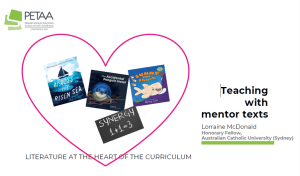PETAA National Conference Canberra, October 2023

PETAA National Conference, Canberra, October 2023: a reflection by Lorri Beveridge
1 Feb 2024
Here are some of my favourite sessions, with tools for your teaching toolbox elaborated for you…
Wordplay: Maxine Beneba Clarke, author
I loved meeting Maxine Benebe Clarke, participating in her session, and learning about her work. Maxine shared many fantastic tools for the teaching toolbox. When I outlined my latest work on the link between music and early reading, Maxine suggested her publication, ‘It’s the Sound of the Thing’. It’s a book of poetry that bops and beeps and zings with musical rhymes and rhythm, fantastic for building soundscapes with voice and simple percussion to build vocabulary and meaning. . . Her work focuses on diversity.

100 new poems for young people – packed with engaging rhymes and rhythm patterns for primary children, to build musical concepts at the same time building a love of poetry.
Some of Maxine’s suggested teaching tips and tricks include:
- Your voice is unique to you. Your strength is bringing all of you to the classroom.
- You need to have an onomatopoeia in every sentence, eg I wish to go to the pop and plop. It’s time for crunch and munch.
- Personification, eg My pencil is tired.
- Using rounds – in the classroom.
- Passing notes – writing in code.
- Found narratives – eg in letters (epistolic)
- Found non fiction narrative – looking at voice.
- Found poetry eg dog park notice.
- Literature is all around us. Draw on it in the classroom. Don’t discount anything as a learning tool.
- Short persuasive texts can change the source of history.
- Speculative fiction or fantasy is a favourite genre.
- Writing about other worlds is higher order, imaginative and fun.
- Share stories.
- Use a metronome to keep the beat while reciting poetry.
- Sesame Street writers ‘master the addictive qualities of Sesame Street and do something good with it…’ – sounds put to music and movement.
Lorraine McDonald
Lorraine has been a personal hero for many years. Her signature texts, “Exploring how texts work”, are firm favourites of generations of teachers. I was particularly excited to hear Lorraine’s presentation as she shared that she is considering retirement. Lorraine extrapolated on field, tenor and mode. She used great examples of quality texts to elaborate on content. Her main ideas included:

- Not all texts are suitable for close study.
- Close reading of a novel includes focusing on setting – physical, location, direction, time, weather.
- Scene shifts and phases – how scenes shift.
- Emotional setting – which are positive, negative. Relates to mood. Includes judgement and appreciation.
- Vocalising character- 1st person narrative, the eyes we see through, the voice we hear including appearance, actions and words – stated and implied.
- Lorraine suggests the teacher models literal level codebreaking during modelled reading and writing activities, and students orally and collaboratively complete the higher-level comprehension tasks.
- Turning up the volume using vocabulary. Draw on vocabulary clines. Nudge students, notice and steal useful word associations.
- Style – a deliberate choice by the author/illustrator. Explicitly unpack author style which may include text layout and punctuation usage. Identify non-standard/ colloquial English. Visual affordances: how visuals are represented – the whole is greater than the parts.
- The divergence between visual and verbal text. Visual grammar for representation. Expert audience – kept at a distance. No judgements – no attitudinal affordances. Sentence fragments – have no verb. Social distance? Collocations – linking a particular word with another word or words with a frequency greater than chance eg: fast food, strong tea, heavy drinker.
- Build cohesion in student writing using sentence starters – stop before the verb.
- Being a ‘writing thief’ (McDonald).
- Use high engagement, quality texts as modelled texts for writing teaching.
Alison Lester

Alison Lester speaking at PETAA 2023 Conference, Canberra.
Alison read “Our Island”. She explored different ways to make images eg: tissue, painting, using various types of materials, torn paper.
“The Fighting Town” is an example of a simple little photo book, by Borroloola School students. Alison used stencilling in the creation of this text. ‘Stencilling gets kids to be creative, with a limited palette’. Alison’s texts are testament to the power of the arts to engage students.

‘Our Island’, a collaboration between Lester, Honey and students at Borroloola School.
Alison’s work features highly in my work using quality texts and music to build reading prosody in early reading classrooms. I used the text, “Sing me the summer” (Godwin & Lester, 2020) and co-wrote a melody accompaniment to the words, to help young children build their fluency. The words and music are in my latest text, “The music and early reading partnership”, chapter 3. I also used a series of simple texts by Alison, “Talk to the Australian Animals” series, to build early readers’ rhyme, rhythm and expression in their oral reading.
Lorri Beveridge & Jubilee Smith
During our session, we articulated the link between early reading acquisition and music. We drew on quality texts as vehicles to integrate reading and music. We shared teaching strategies that enrich reading and music practice using contemporary, quality literature. Our main message was one of advocacy. We advocated for the importance of the arts, in particular music, as a universal human experience that benefits all learning at school and in life.
Quality text selection used in presentation to reinforce the early reading and music link.
The power of voices raised together in song – my favourite part of the presentation. We concluded by singing and playing simple and body percussion together.
